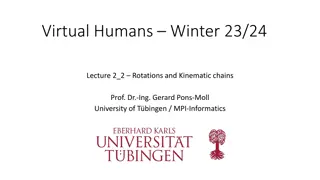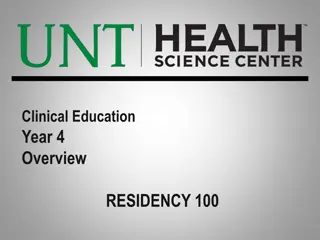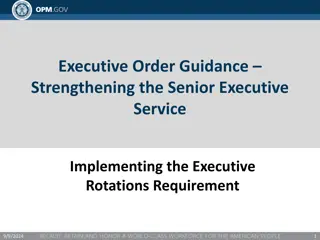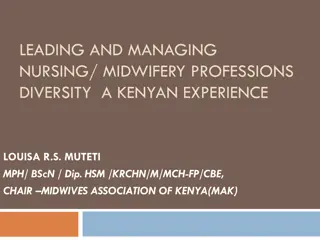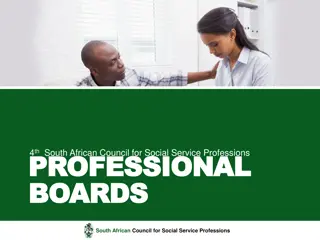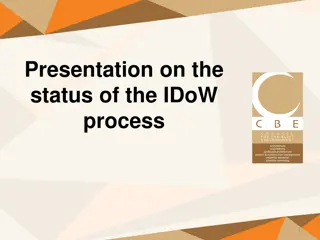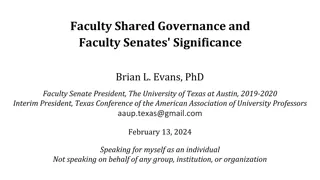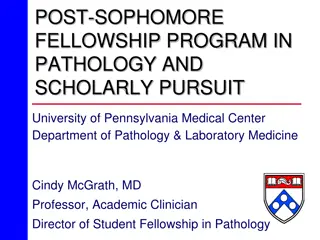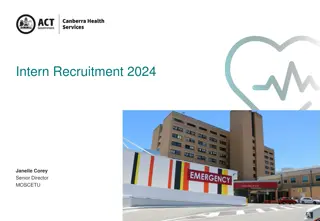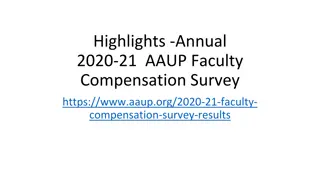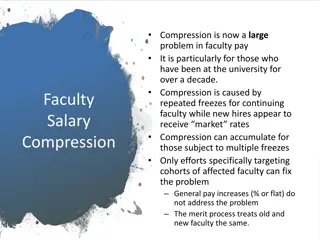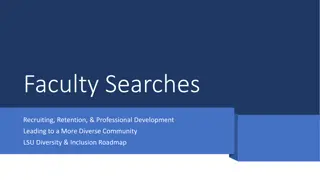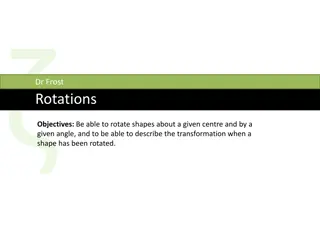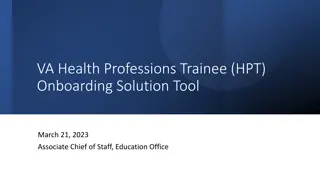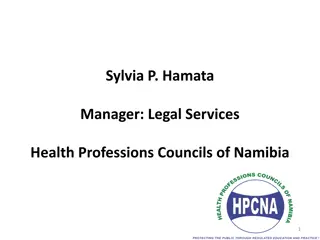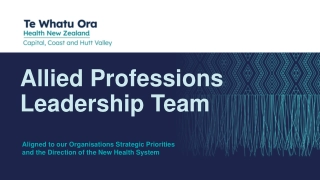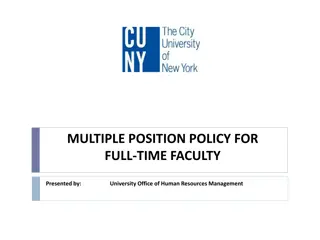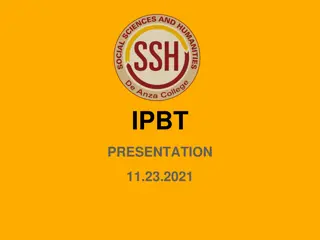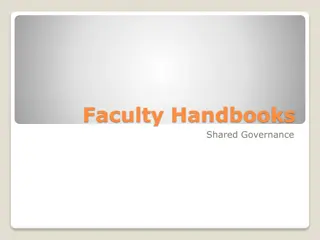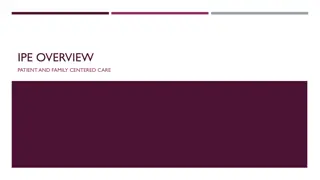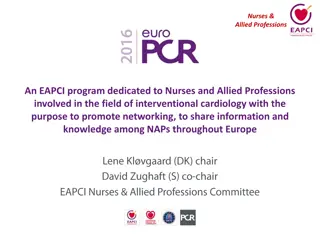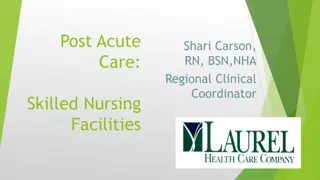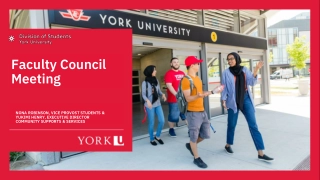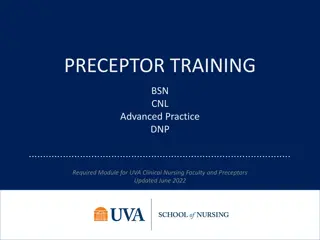Navigating Challenges in Clinical Rotations for Health Professions Faculty
This presentation highlights the challenges and choices faced by health professions faculty in clinical rotations, focusing on identifying opportunities and resources for limited clinical experiences. The content covers fundamental terminology, options available, and strategies such as on-site and remote learning. It also discusses challenges and solutions in on-site clinical learning, including site availability, screening tools, and orientation procedures.
Download Presentation

Please find below an Image/Link to download the presentation.
The content on the website is provided AS IS for your information and personal use only. It may not be sold, licensed, or shared on other websites without obtaining consent from the author. Download presentation by click this link. If you encounter any issues during the download, it is possible that the publisher has removed the file from their server.
E N D
Presentation Transcript
Challenges and Choices for Clinical Rotations in Health Professions Faculty Focus Group July 24, 2020
Introductions Kate Newman, PharmD Director of Experiential Education Clinical Associate Professor of Pharmacy Practice SIUE School of Pharmacy phone: 618-650-5167 kmuhlst@siue.edu Sheri Compton-McBride, DNP, RN Director of RN/BS Nursing Program, Director of Acquisition of Clinical Sites, and Contract Management SIUE School of Nursing phone: 618-650-3341 shcompt@siue.edu
Goal Identify opportunities and resources to consider when facing unique challenges of limited (or lack of) clinical experiences traditionally offered through a hands-on format.
Fundamentals Terminology Discipline specific; interchange Consider & determine the role Student or provider? Critical Partnerships Sites/Agencies Vendors/Supplies Campus Partners: Legal Health Services Counseling Services Access
What Options Do We Have? Accreditation/program requirements Is simulation or remote rotations allowed? Required learning outcomes? How many hours are required? Are there limitations on learner to facilitator ratios? Any changes in guidance during COVID-19? Site closures or furloughs that impact the programmatic training? State or professional regulation limitations? Preceptor to student ratio Required preceptor training; contact hours expectations Practicality of a traditional hands on experience
Four Different Strategies On-Site Simulation/Labs On-Site Clinical Learning Remote Simulation/Labs Remote Clinical Learning Each of these strategies has their own challenges, resources & solutions
On-Site Clinical Learning (Onboarding) Challenges Site/Partner Availability How to determine if sites are available Site Requirements/Screening Prior to Experience Different Temp cut-offs for different organizations Pre-experience screening (who is in charge)/how will it be handled Orientation How to train on equipment, etc. PPE Concerns How will we get it//How to distribute/How to pay for it Solutions Site Availability Qualtrics Form Screening tools created using Qualtrics and other systems Ex: CastleBranch (https://discover.c astlebranch.com/covid-19- resources-cu/) Orientation option to do virtual/use Zoom
On-Site Clinical Learning (During the Experience) Challenges Areas of practice where students can be risks of exposure to COVID Post-Conference & discussions about patients can t be held like they used to due to limitation of room availability and social distancing precautions Zoom + HIPAA Concerns Solutions Zoom: Password protected Zoom meetings / generate new IDs frequently or with each session / ensure no recording is happening / utilize waiting room Doximity available free for healthcare providers & a HIPAA compliant option: https://www.doximity. com/
On-Site Clinical Learning (post-COVID exposure) Challenges Policy for handling post- exposure issues/quarantine Time lost if not on site Safety of site/agency/patients CDC and IL Dept of Health to guide policies Other impact on classes? Who do we communicate within our own programs or across campus Grading concerns how will this affect progression for students affected? Solutions Consider short-term switching to another instruction method (remote/simulation)
On-Site Clinical Learning (Logistics) Challenges How do we keep track of students? Absences/Switched Days/Rescheduled to a different area than the original schedule Important for contact tracing if positive case and to ensure they meet all accreditation requirements Work experience? Do they have exposure while at work how to screen for that before coming to a clinical site? Solutions Rotation Management Systems can help track students (including clocking in and out of rotation sites ) Pharmacy uses CORE ELMS (https://corehighered.com/) Other options: E*Value (https://www.medhub.com/evalue/e value-product/) PharmAcademic (https://www.mccre adiegroup.com/solutions/residency- programs/)
Remote Clinical Learning Challenges Getting real-time patient care experience Ensuring HIPAA compliance Many of the previous challenges still apply Solutions Request access to health records How to share information with preceptor (using secured messaging/secure video chatting/deidentify patient-sensitive information when possible)
On-Site Simulation/Lab Solutions Marking Entrances Exits Clearly (floor/desk/door marking) Allowing time to Disinfect Rework some activities Resources/expertise from other faculty focus groups Partner with other groups on campus to share resources Challenges Clearly marking areas/disinfecting/ensuring appropriate social distancing Some learning activities need to be developed/created for independent learning Cost of Simulation Resources Adapt pre-brief and debrief (virtual) Safe space learning
Remote Simulation/Labs Challenges Ideas to meet competencies/challenges related to IPE (can t get big groups together easily) Inability to see first-hand different areas of practice Solutions Activities that could be done via Zoom Using Standardized Patients in Zoom Virtual Experiences Prompts for critical thinking and enhance psychological safety Virtual Field Trips Some examples found: Nurse got blood from the blood bank/wound center/procedural areas Tour of space/location Opportunities to join more meetings that are now available
Resources VPPL - Virtual Professional Practice Lab (Mursion) https://www.siue.edu/virtual-practice-lab/ https://www.youtube.com/watch?v=BbY6ZmezvgU&feature=youtu.be 5-8 minutes, then debrief. Cost prohibitive in some cases Case studies Use of video Discussion questions Standardized clients/patients Scripting and roles IPE/Integration with colleagues (i.e.: theater students)
COVID Silver Linings Creativity and value of the work Graduate assignment/activity provide permission to allow undergraduates to use. Medication reviews for the campus community Development and/or updates to current assignments/case studies Enhanced use and competence with technology Application of knowledge translated to a virtual environment Collaboration among University schools/departments Faculty or student development to become Virtual Professional Practice Lab (VPPL) avatar trained to serve as the standardized client Capitalize and serve as good stewards of resources by collaborating with university colleagues Fluidity...more than flexibility.
Quality Assurance Reflection on Implementation Student Clinician Site/Partners Evaluation of virtual learning Formal and informal Qualtrics What to expect of our students and consumers? What are the outcomes that we don t expect by implementing new processes or services? Students social isolation and access/availability of health and counseling services in virtual format Market perception/advertising to current and prospective students
THANK YOU! Jennifer Arnoldi, PharmD Angela Andrews, PhD, RN Amy Reed, MS, RN Kay Gaehle, PhD, RN Jodie Nehrt IDLT Lynn Bertels SIUE faculty colleagues, staff, leadership and administration




